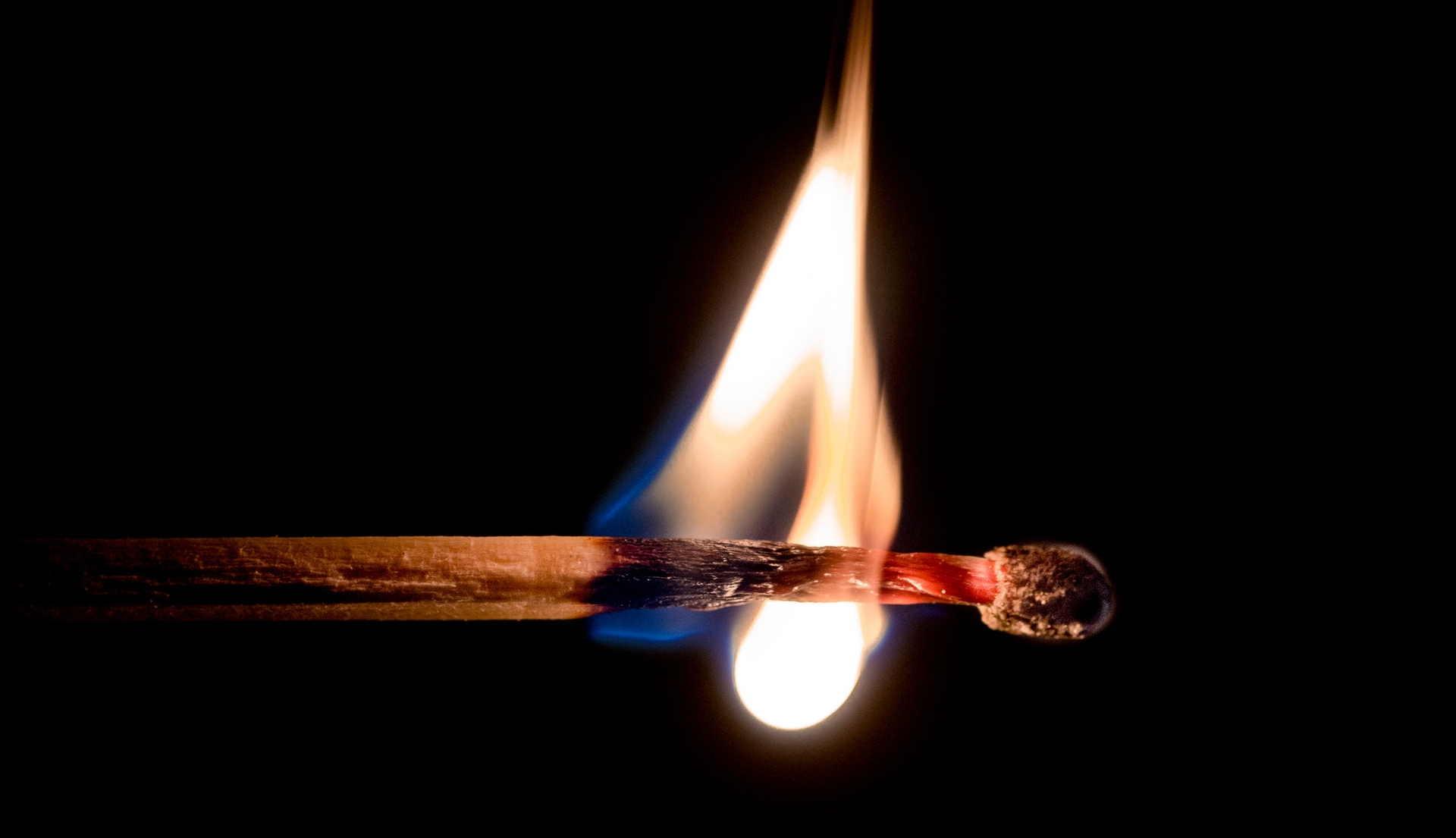Why are heatwaves more frequent and more intense?
Hot Weather Is Becoming a Serious Problem
Extreme heat is by far the leading cause of weather-related deaths in the United States, according to the National Weather Service. More fatalities are caused by extreme heat than by hurricanes and tornadoes combined. Even where heat events don’t lead to fatalities, working in hot conditions reduces productivity. It stands to reason that the impacts of extreme heat events will only increase as the climate warms. As an example, the International Labor Organizationº projects that by 2030 the equivalent of more than 2 per cent of total working hours worldwide will be lost every year
Governments worldwide recognize the increasing threat to human health. This summer the U.S. government launched the National Integrated Heat Health Information System (NIHHIS) and its Heat.gov web service. The NIHHIS is part of the Global Heat Health Information Network, established in 2016 by the World Health Organization and World Meteorological Organization Joint Office for Climate and Health, and the United States National Oceanic and Atmospheric Administration (NOAA) Climate Program Office.
As you might imagine, climate warming is making the situation worse.
2022 Heatwaves
So, how do we recognize dangerously hot weather? The bellwether is a “heatwave” — at least three consecutive days with a maximum temperature above the average for the location and the time of year. Key characteristics of heatwaves are their duration, intensity, frequency and the length of the heatwave season.
Given the variability of climate around the world, the intensity of heatwaves varies from place to place. Thus a London summer heatwave might peak at 90ºF, but the same temperature in Las Vegas wouldn’t attract a moment’s notice.
Heatwaves are certainly in the news this year. Let’s recap 2022 so far with a few notable events:
- India and Pakistan – a severe and persistent heatwave lasted from March through May and set many new all-time high temperature records in both countries, including 49.0ºC (120.2°F) at Jacobabad, Pakistan (see our Extreme Weather post)
- China – Shanghai’s 25 million people endured a record high temperature of 40.9ºC in July. Previously Shanghai had only logged 15 days above 40ºC in nearly 150 years of record keeping. Elsewhere in eastern and southern China, authorities warned of temperatures as high as 42ºC.
- U.S. – record heat in Texas and Oklahoma earlier this summer moved eastward to the southeastern states and finally the Northeast. By July 20, more than 154 million people were under heat warnings or advisories according to the NIHHIS. Roughly 60 million people in at least 16 states experienced temperatures over 38ºC (100ºF) on July 21. A midsummer heatwave in the Northwest put 11 million people under excessive heat warnings.
- Japan – recorded six consecutive days over 35ºC (95ºF) for the first time ever
- Europe – Persistent heatwaves have plagued Europe, causing wildfires, droughts, and evacuations. The highest recorded temperature was 47.0ºC (116.6ºF) in Pinhão, Portugal. Over 2,000 people are estimated to have died in Portugal and Spain alone. In Italy, Rome set an all-time temperature record of 40.8ºC (105ºF) in late June and Tuscany set a June record of 41.8ºC (107ºF). Italy is experiencing its worst drought in 70 years. Temperature records were broken across France, with numerous cities recording temperatures over 42ºC.
- UK – reached a temperature of 40.3ºC (104.5ºF) at an air force base in Lincolnshire, the highest temperature ever recorded in the UK. Six other locations, including London, recorded temperatures over 40ºC.
Individually, the above events are remarkable. Together they make up an extraordinary global-scale event of concurrent heatwaves throughout most of the Northern Hemisphere.
The intensity and extent of the July heatwave in Europe is captured in the NOAA map below.
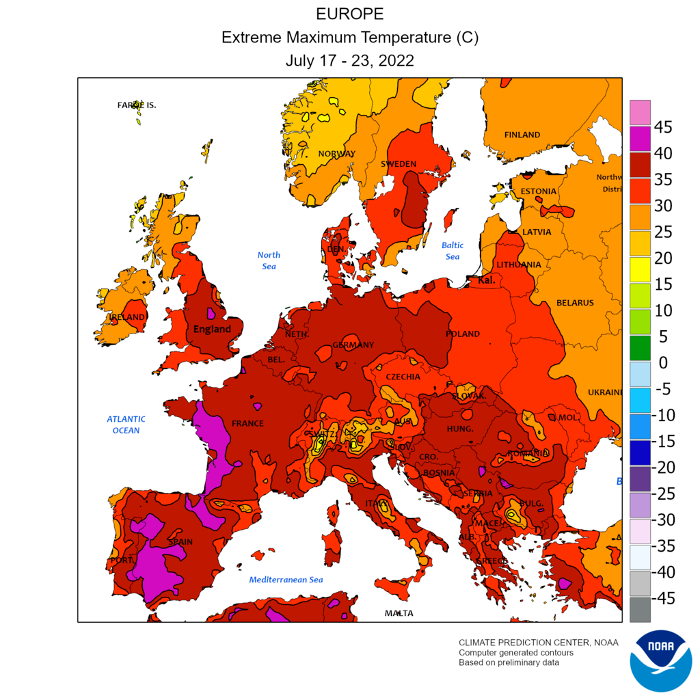
The continent-scale heat event in the US is illustrated in the dramatic NASA map below. Representing daily high temperatures on July 31, the map highlights the many areas at or near triple digit (fahrenheit) highs.
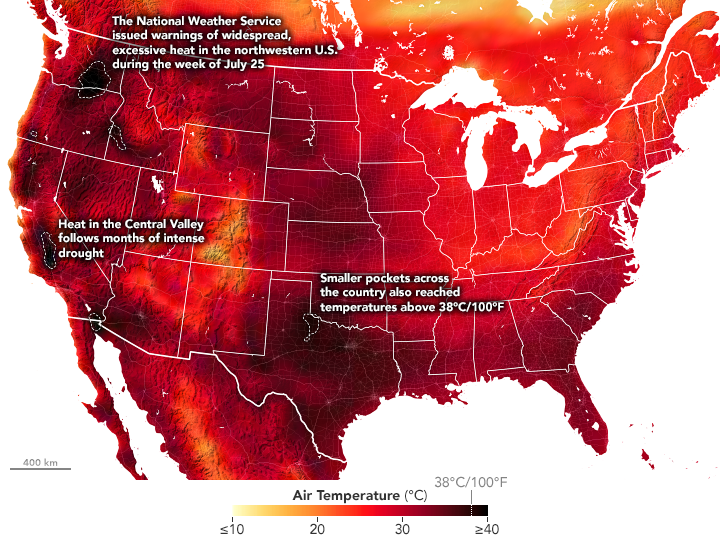
The following graph shows just how exceptional was the UK July heatwave. London’s Heathrow airport was one of the UK sites to log a temperature record above 40ºC. Note the difference between a “normal summer” and midsummer 2022! Nearby, the heat forced London Luton Airport to shut down due to runway damage, while the Royal Air Force was forced to suspend operations at the Brize Norton airbase because parts of the runway were melting.

Credit: R.A. Rhode, Berkeley Earth (via Twitter)
Another view of the UK heatwave is shown in the graph below. The red line represents 2022 daily high temperatures at the Coningsby airbase, culminating in the new UK national record, fully 5ºC higher than any other daily maximum in the last 50 years.
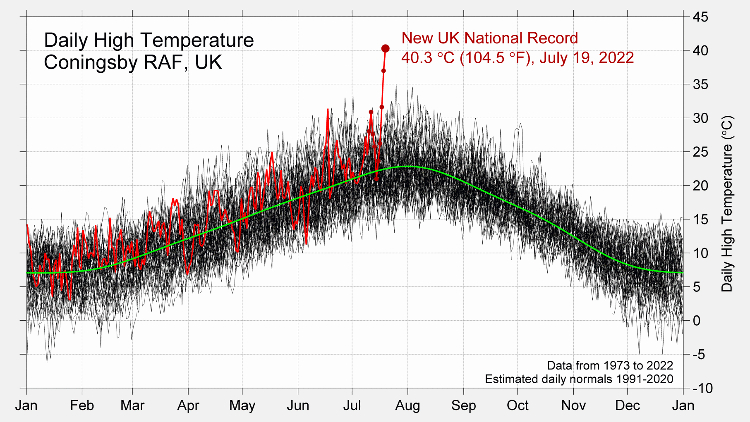
Credit: R.A. Rhode, Berkeley Earth (via Twitter)
Heatwave Impacts
These climate events have far-reaching societal and economic impacts.
Human Health
Of greatest concern are the impacts on human health. High temperatures can lead to death, often because they exacerbate pre-existing conditions like respiratory issues or heart disease. Through the end of July 2022, heat-related deaths in Europe totalled nearly 12,000. The 2003 heatwave in Europe contributed to 70,000 deaths.
Record temperatures aside, Europe’s generally milder climate history means that it is simply ill-equipped for hot weather. For example, in England, just 2% of homes have air-conditioning. In the US, it’s nearly 90%.
Human health also has non-fatal responses to heat stress which affect a much broader portion of the population. From an economic point of view, the resulting loss of labor productivity for outdoor workers and indoor workers in facilities without air conditioning can be massive. The International Labor Organization estimates (pdf) that the global financial loss due to heat stress was $280 billion in 1995. That number is expected to be $2,400 billion by 2030 — a productivity loss equivalent to 80 million full-time jobs. The ILO projection is optimistically based on restraining climate warming to 1.5ºC this century — a goal we are very unlikely to reach.
Infrastructure
Economic impacts of extreme heat events also extend to infrastructure damage. During this year’s July heatwave, infrastructure designed for a cooler climate began to fail. Roads and airport runways surfaced with resilient materials designed for cooler climates began buckling and melting. The UK railroad network suffered from rails warping and overhead wires failing under heat beyond their design limits.
Airports can have other issues in extreme heat events. Some aircraft are unable to take off in very hot and less dense air, leaving planes stuck on the ground in hotspots like Phoenix or Dubai. Smaller aircraft (think regional jets) are particularly affected. Today’s interconnected, hub and spoke airline networks are especially vulnerable to local flight cancellations leading to delays and cancellations throughout the network.
Electric power grids are particularly vulnerable to extreme heat (looking at you, Texas), caught between declining power generation on one hand, and increased demand on the other.
In a heatwave, air conditioning drives electricity demand, of course. In the US, about 90% of electricity is generated by thermoelectric power plants (typically coal, oil, gas-fired, or nuclear.) These plants require lots of water, primarily for producing steam to drive the power turbines and for cooling and condensing the steam afterward. The warmer the water supply, the less efficient the power generation. Nuclear plants need more water for reactor cooling when the water is warm. If water supply is limited, they have to reduce production.
Power plant access to water is not unlimited. In 2015, US thermoelectric generation required about 130 billion gallons of water per day, led by Texas and Florida. As climate warming and heat events lead to more frequent and more severe droughts, competition for diminishing water supplies will increase.
Droughts and Agriculture
Droughts and extreme heat go hand in hand. A combination of the two can have a devastating impact, particularly on agriculture and wildfires.
We’ve discussed the multi-decadal western US megadrought and its connection to a warming climate. However, most droughts are comparatively short-lived, often closely linked to heatwaves. This is the case in the summer of 2022.
Consider the continental US. The map below shows that nearly every state experienced above normal temperatures during the July 2022 heat event, with a large swath of the western and south-central states experiencing either a much above average or a record month.
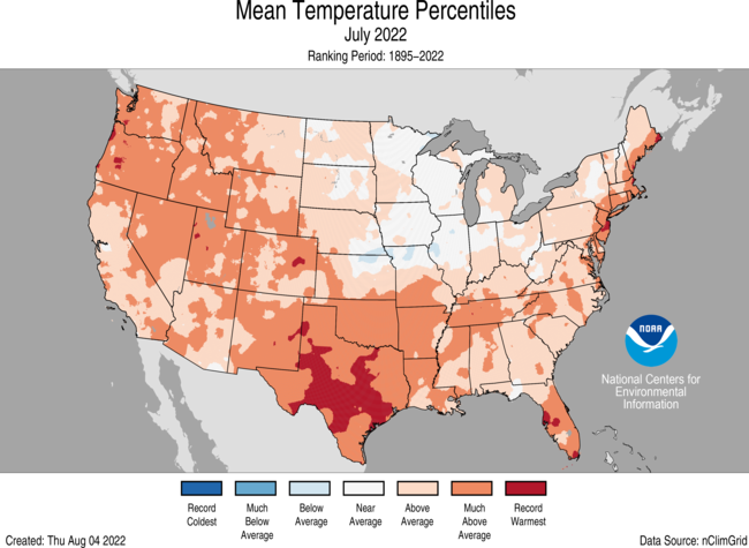
Now, look at the 2022 US drought situation as of the beginning of August. The link between higher temperatures and more severe levels of drought is striking.
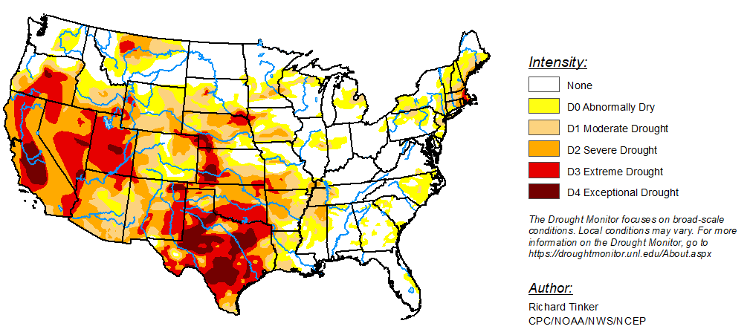
US Drought Situation, August 2022
A similar scenario is playing out in Europe, with drought conditions existing over much of Europe even before the July heatwave. The data shown in the map below use NASA satellite data to calculate an Evaporative Stress Index — an estimate of the amount of water evaporating from the soil and vegetation (brown indicates dry conditions and darker shades are drier.)

Surface and vegetation dryness, averaged from late June to late July. Credit: L Tierney, Washington Post
Andrea Toreti, senior scientist at the European Commission’s Joint Research Centre, is quoted by a SkyNews climate reporter as believing that the data so far show that this will be the worst drought in 500 years.
The ongoing drought in Europe has already diminished flow in the Rhine and Danube rivers to the point where vessel traffic has been curtailed.
Meanwhile, ongoing high temperatures and continued lack of rain by early August led the UK Environment Agency to declare an official drought for eight regions in the south of England, with more regions likely to be added later in August.
Agriculture is hard-hit by the combination of drought and high temperatures in both the UK and Europe.
In the UK, the potato crop will be cut in half, and the maize (corn) crop is in trouble. Lack of feed for cows is reducing milk production.
Drought is also cutting maize production across the European Union, with production in France at its lowest level in a decade. Other major producers, like Romania and Italy, are also in deep trouble. Lack of maize translates into a lack of feed for the EU livestock herd.
Just like people, livestock can die from heat stress during a severe heatwave. This happened in Kansas in a June 2022 heatwave, when consecutive days of triple digit temperatures led to the sudden death of at least 2,000 cattle. In these circumstances, the cattle can’t be used for human consumption, so they are typically processed into pet food or fertilizer products. In this case, so many cattle died so quickly that processing facilities were overwhelmed, and thousands of cattle had to be hurriedly disposed of in landfills and unlined pits.
Less drastically, ranchers across the western US are reducing their cattle herds due to the deepening drought and the high price of feed, driving up the price of beef.
Wildfires
Regular readers will recall that we have discussed the relationship between climate warming and wildfires (here and here.) But this year, the combination of drought with particularly intense and persistent heatwaves led to extraordinary wildfire conditions in the mid-latitudes of the Northern Hemisphere.
In June through August 2022, parts of Europe, the Middle East and North Africa were plagued by a wave of wildfires. The Mediterranean countries of France, Greece, Portugal, Spain and Italy were hit early, hard and often, and the fire season is by no means over. The European Forest Fire Information System (EFFIS) reported that by mid-July wildfires had already burned about 5,000 km2 in the EU, compared to the 4,700 km2 burned in all of 2021. At that rate, 2022 could surpass Europe’s record of 10,000 km2, set in 2017.
As I write this article, Reuters reports that a “monster” fire has erupted in the Gironde region of France. So far, 10,000 people have been evacuated as more than 1,400 firefighters from across the EU battle the fire. Heatwave temperatures as high as 40ºC (104ºF) are expected in the next day or so. The Gironde region already lost 200 km2 to fires in July.
Unlike most of the Southwestern US, Europe is densely populated, which means that wildfires are never far from towns or cities. The Twitter post below shows one of many fires in Greece in 2022 — this one on the outskirts of Athens, home to more than 3 million people.
It’s almost dark and fire has grown a lot from this view from Agia Paraskevi in last half hour. #Πυρκαγια #Pendeli #greecefire #Greece #fire #wildfire #athens pic.twitter.com/CdGDOBPIYf
— Rachelle Galloway-Popotas (@owlinatree) July 19, 2022
The combination of very dry conditions and record setting heat waves in July spread the wildfire risk as far north as London. On July 19th, the day the UK set its new temperature record, London Fire Brigade had its “busiest day since World War II” as record temperatures led to hundreds of fires across the city.

Damage in a London suburb caused by a spreading grass fire. Credit: London Fire Brigade
Wildfires have been widespread in England and Wales during the 2022 heatwave, with more than 440 wildfires recorded by late July, compared to 247 in all of 2021. By August the UK Met Office set its Fire Severity Index to “very high” for most of England and Wales, rising to its highest level of “exceptional” August 13 and 14, for London and surrounding regions.
In the US, the 2022 wildfire season (so far) has seemed almost “normal” compared to the frenetic fire season in Europe. Nonetheless, from January through July 5,712,925 acres burned in the US, the third most on record for the seven month period and only slightly below the record of 6,091,572 acres set in 2011.
A relatively moderate California fire season so far is partly due to improved forest management and partly due to fortunate weather and unmatched fire fighting capability. Nonetheless, drought and rising temperatures have left the forests and the old growth vegetation bone dry and the fire risk high. The spectacular Oak Fire, a fast-moving wildfire near Yosemite National Park took advantage of these conditions to burn through 18,000 acres in just three days in late July.
The western US in general, and California in particular, is more vulnerable than ever to wildfires, the result of relentless climate warming and more than two decades of drought. The two most damaging California fire seasons were 2020 and 2021, when more than 6.8 million acres went up in flames.
To wrap up Part 1 of our heatwave post, I will leave you with this striking video taken beneath the pyrocumulus clouds forming above the Oak Fire. In Part 2 of our heatwaves post we will look at the climate science behind the concurrent heatwaves around the Northern Hemisphere and their increasing frequency and severity.
Surreal apocalyptic scene from the #OakFire pic.twitter.com/ylTyJgoLhb
— Technically J (@Technically_J) July 24, 2022

